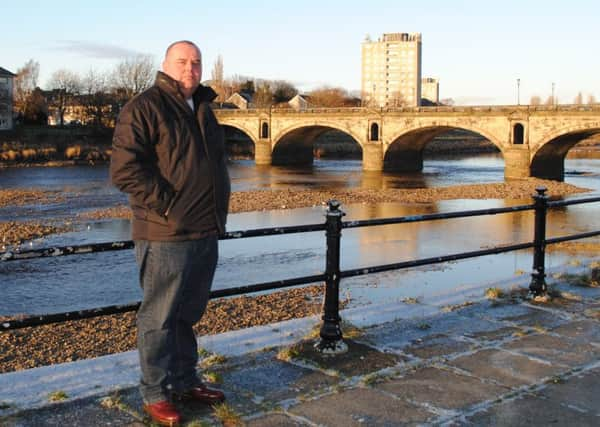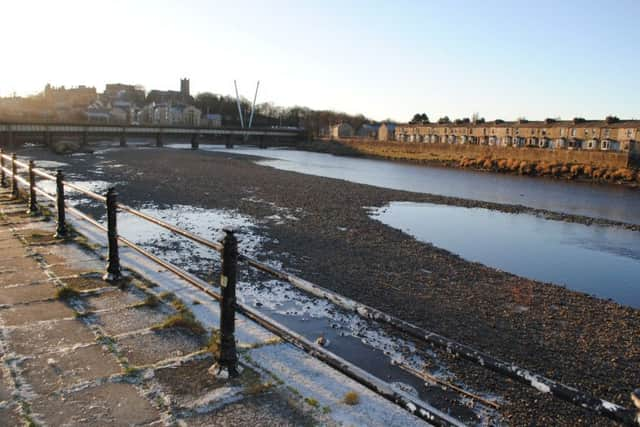Engineer predicts 'catastrophic floods' for Lancaster if Lune isn't dredged


Sean Kelly, who wrote the book Flood: Disaster On The Horizon, in 2010, said that accelerated erosion in the hills has increased the amount of sediment and stone being deposited in the river channel as it widens and deepens, causing a natural blockage.
In a report he wrote in December 2017 about the flood risk in the lower reaches of the Lune Valley, Mr Kelly said that recent more frequent periods of heavy rain were accelerating the process.
Advertisement
Hide AdAdvertisement
Hide AdHe said: “Coupled with this, when the river is at low flow, we have a dominant tidal flow coming into the channel from the Lune Estuary at Sunderland Point. This dominant tidal flow is washing sand, silt and mud up the river channel at high tides and is exacerbating the problem downstream of the weir at Skerton.


“I believe that the normal dry weather flow of the river along its length downstream of Sedbergh isn’t physically capable of clearing the amount of sand, mud, silt and stone being deposited in its channel from both downstream and upstream sources during periods of bad weather.
“This is causing the river channel to become blocked at an alarming rate, which in turn is now, in my opinion, beginning to cause the floods that we have experienced in the Lune Valley recently.”
He said that failure to keep the channel free from man-made or natural obstruction will result in catastrophic flooding in the future.
Advertisement
Hide AdAdvertisement
Hide AdHe has now called for the removal of gravel and stone deposits along the Lune’s channel “from Sedbergh to Skerton Weir” and on to its estuary in Morecambe Bay, in order to alleviate future flooding in the Lune Valley.


“Failure to remove these blockages will only result in the river bursting its banks in more and more areas in the future, as storm water struggles to get past the ever increasing blockages,” he added.
The river Lune is around 53 miles in length and drains water from parts of the Lake District, the Western Pennines and the Trough of Bowland.
It is supplied by fast flowing and steep tributaries and secondary rivers.
Advertisement
Hide AdAdvertisement
Hide AdRecent ongoing work by the Woodland Trust and Natural England to plant around 60,000 trees upriver on Tebay Common already seems to be having some positive effects on the flow of water in the Lune.
A study by Lancaster University’s Environment Centre concluded that recent planting on gley soils on Tebay Common, and in similar settings, are likely to show the first signs of improved drainage during flood events within a few months of planting.
Mr Kelly said that in the meantime, the authorities had to act to remove as many of the current blockages in the river as possible, both mechanically and by hand.
“In effect, the river is relatively self-cleaning to the north of Sedbergh, however downstream of Sedbergh the river is unable to clean itself and assistance is required in order to keep the channel free flowing.
Advertisement
Hide AdAdvertisement
Hide Ad“The larger stones removed could be used for Gabion Baskets (a large wire cage filled with stones), these in turn could be used to shore up areas of the river bank where the bank erosion is at it’s fiercest.
“Secondly, we need to prevent further massive migration of small stones and sediment from the higher reaches.
“This could be achieved by the construction of ‘catch pits’ in the higher stretches of the river.
“Deep pits would be dug in the bed of the river at strategically planned sites and during the drier summer months.
Advertisement
Hide AdAdvertisement
Hide Ad“The flow of the river could be maintained during this construction by way of a ‘pipe bridge’, conveying flows from one side of the pit to the other whilst the pit is constructed.”
Mr Kelly has 25 years of experience working in flood management investigations and drainage inspections.
“Once completed, the pipe bridge would be removed allowing the river to naturally fill the pit and continue on it’s course.
“Future migration of stone and gravel into lower reaches would be stopped in its tracks and the pit would begin to fill with it instead.
Advertisement
Hide AdAdvertisement
Hide Ad“The pit could then be maintained and emptied at regular intervals causing minimal disruption to the natural environment of the watercourse.
“The data gathered from the amount of sediment removed would prove invaluable in the future as it would help in calculating just how serious the problem has become.
“Paying farmers to allow their land to be flooded would also help in preventing flooding in the future, man-made loose wood dams could then be constructed across the river in strategic points, these dams would slow the rate of water travelling downstream during periods of bad weather and would allow storm water to back up into fields, where it would be released gradually into the lower reaches.
“Turning these flood fields into woodland areas would also enhance the environment by providing additional habitat for local wildlife.
Advertisement
Hide AdAdvertisement
Hide Ad“Ponding of the river could also help to prevent future flooding.
“Again, constructed in strategic areas, these ponds would be constructed along the line of the river.
“Basically large areas of the river bank would be widened across farmland in order to form a large on-line pond.
“These ponds would be deep enough to be constantly supplied with water from the normal flow of the river, but they would also have high bunded banks which would enable the pond to store stormwater during bad weather.
Advertisement
Hide AdAdvertisement
Hide Ad“These bunded banks would be constructed from the material removed from the river bank and again they would enhance the environment by providing additional habitats.
“If we could combine flooding farmland with the planting of trees and the construction of online ponds along the Lune Valley, we would not only be lessening the effects of flooding in the future, but we would be turning what is currently little used farmland, into a nature haven.
“It could be used as a blueprint for future schemes across the country and, one day, we might be free from the dread of flooding once more.”